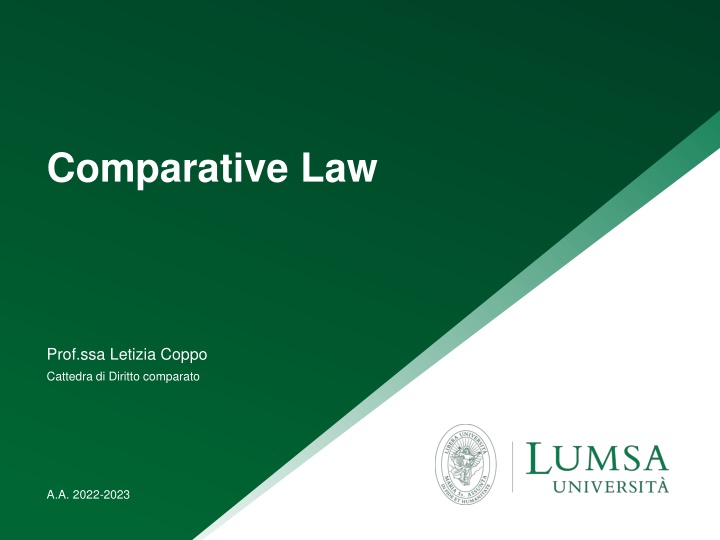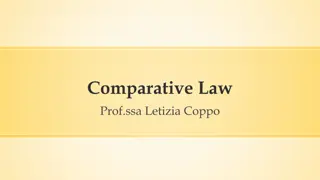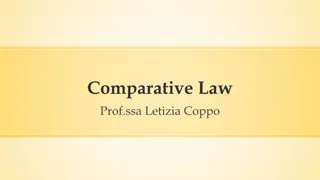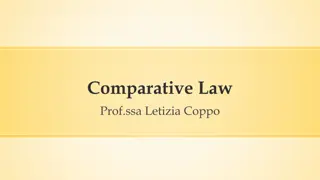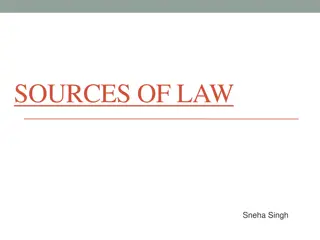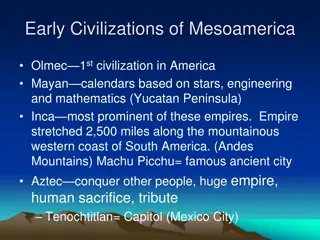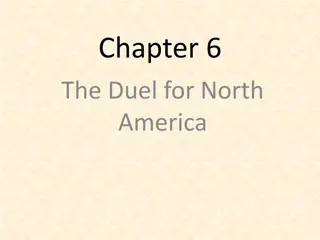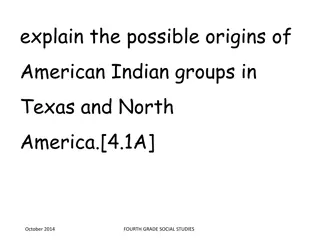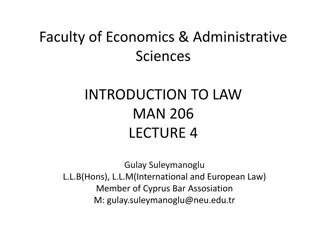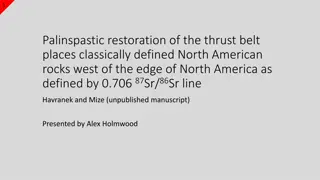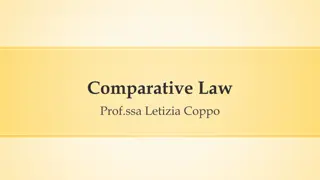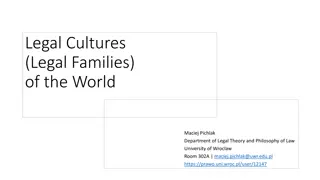The Historical Origins of North American Common Law
The North American legal family's recent origins compared to other traditions, beginning with the 13 colonies in the early XVII century. Disputes initially resolved using the Bible evolved into the common law system inherited from England. The evolution of American law is marked by significant events such as the Declaration of Independence, the Federal Constitution, and the Civil War, leading to the US becoming a major influence globally due to its unique blend of legal traditions.
Download Presentation

Please find below an Image/Link to download the presentation.
The content on the website is provided AS IS for your information and personal use only. It may not be sold, licensed, or shared on other websites without obtaining consent from the author.If you encounter any issues during the download, it is possible that the publisher has removed the file from their server.
You are allowed to download the files provided on this website for personal or commercial use, subject to the condition that they are used lawfully. All files are the property of their respective owners.
The content on the website is provided AS IS for your information and personal use only. It may not be sold, licensed, or shared on other websites without obtaining consent from the author.
E N D
Presentation Transcript
Comparative Law Prof.ssa Letizia Coppo Cattedra di Diritto comparato A.A. 2022-2023
The Nord-American Common Law
THE NORD-AMERICAN COMMON LAW The historical origins The North American legal family has recent origins compared to the ones of the other traditions. The first relevant period is the first half of the XVII century, the time of the famous 13 colonies. They had little contacts with each others and their links with England were rather loose. There was no need for courts or lawyers; securing survival was the priority. 3 Universit LUMSA
THE NORD-AMERICAN COMMON LAW The historical origins Possible disputes were settled by ministers with the Bible, rather than by lawyers with the common law. At the beginning of XVIII century, the increasing trade among the colonies and with England strengthened the connection with the mother country. England, with its Inns, became the reference point for training and Blackstone s work spread English law. 4 Universit LUMSA
THE NORD-AMERICAN COMMON LAW The historical origins Colonies agreed that their governing law should be in principle the common law of England, supplemented by local statutes. But several people moved to America right because they were politically, spiritually or economically oppressed by their home country. Thus, several statutes were enacted. A thirst for a more egalitarian and democratic society and the ideals of the French Revolution lead to an alteration of English law. 5 Universit LUMSA
THE NORD-AMERICAN COMMON LAW The historical origins Since then, the most relevant events have been: the independence war, which lead to the 1786 Declaration of Independence and to the 1789 Federal Constitution (the core of which is still in force), signed by several lawyers; the 1861-1865 secession war, with all the problem of slavery, that has been haunting the US for a long time. 6 Universit LUMSA
THE NORD-AMERICAN COMMON LAW The historical origins The US have gradually become one of the most influential countries in the world and the essence of such development can be identified in the double institutional heritage of the two legal families of the Western Legal Tradition that American law has been capable of metabolising and transforming into something original. 7 Universit LUMSA
THE NORD-AMERICAN COMMON LAW The historical origins From common law, through Blackstone, American law inherited a strong, powerful, independent and prestigious judiciary, main character of the whole legal history of the country. From civil law (especially the German family), American law inherited influential law schools and streams of legal thought. 8 Universit LUMSA
THE NORD-AMERICAN COMMON LAW The historical origins The result was the elaboration of original models, flexible and capable of adapting to different legal context, therefore suitable for circulation and transplant. The peculiarities of the Judiciary, linked with the strong influence of the Constitution and the Federal structure, and the peculiarities of American law schools and legal profession are the most distinctive elements of the system. 9 Universit LUMSA
THE NORD-AMERICAN COMMON LAW The Constitution and the judicial review The judicial review is the main tool that enabled the judiciary to acquire its leading institutional role in the US legal system, since Marbury v. Madison. Basically every judge is entitled to check the compliance of statutes or administrative acts with the Constitution. In case of non-compliance, the single courts are entitled to disregard the statute or act. Only the Supreme Court, though, has the power to declare the act unconstitutional. 10 Universit LUMSA
THE NORD-AMERICAN COMMON LAW The Constitution and the judicial review The up-taking of the Supreme Court role is linked to the character of Chief Justice Marshall. With Marbury v. Madison he held that the Supreme Court was entitled to review the compliance of federal statutes with the federal Constitution. He held that the Supreme Court had the power to declare State laws unconstitutional and overturn state courts decisions. 11 Universit LUMSA
THE NORD-AMERICAN COMMON LAW The Constitution and the judicial review A remarkable invention by Marshall was the opinion of the court , which gives Chief Justices a great power, as he commits him the choice of the justice who will speak in the name of the Court as a whole. One voice (unanimity or majority) and one holding. Dissenting opinions existed, suspiciously as they are a hint of a possible fragmentation of the Court s unity. but were looked at 12 Universit LUMSA
THE NORD-AMERICAN COMMON LAW The Constitution and the judicial review Structure of the Constitution 7 original articles that show the conflict between federalist ideas, willing to build a unitary State, and the fear that a firm union would kill the rights, powers and sovereignty of the single States. The key principle was Montesquieu s separation of powers. 13 Universit LUMSA
THE NORD-AMERICAN COMMON LAW The Constitution and the judicial review Arts provisions on individual rights: e.g. prohibition of ex post facto laws; right to a trial by jury and to natural judge. 1,2,3: organisational provisions and some Art 6: Supremacy clause : the Constitution shall be the supreme law of the land. Constitutional pyramid with the Supreme Court (and its overruling power) on top. 14 Universit LUMSA
THE NORD-AMERICAN COMMON LAW The Constitution and the judicial review Amendments coming from the Bill of Rights (1791): while the English Bill of Rights, enacted under the Stuarts, basically contained political rights (together with some individual rights like the one against cruel and unusual punishment), the American one was focused on individual rights. The American Bill of Rights was influenced by natural law and Enlightenment ideas. The list of rights was typical and prevalent. 15 Universit LUMSA
THE NORD-AMERICAN COMMON LAW The Constitution and the judicial review First Amendment: establishment clause. Freedom of religion, speech, press, assembly and petition to the government. Fourth Amendment: prohibition of unreasonable searches and seizures. Procedural rights. Fifth Amendment: right to a Grand Jury; double jeopardy prohibition; nemo tenetur se detegere; due process and just compensation clause. 16 Universit LUMSA
THE NORD-AMERICAN COMMON LAW The Constitution and the judicial review Procedural due process: right to a fair trial; freedom, life and property cannot be infringed without formal guarantees, among witch the right to equality of arms an to a trial by jury. Substantive due process: void for vagueness clause; culpability; freedom of contract (see how the latter hindered the enforcement of Roosvelt s New Deel policies on labor law). 17 Universit LUMSA
THE NORD-AMERICAN COMMON LAW The Constitution and the judicial review IX Amendment: The list of rights contained in the Constitution cannot be interpreted as to exclude or limit other rights. X Amendment: the powers that are not expressly awarded by the Constitution to the Union keep un belonging to the States. 18 Universit LUMSA
THE NORD-AMERICAN COMMON LAW The federal system The system is based on a separation between the competence of the States and the competence of the Federation, the borders of which, though, are not always well defined. According to the X Amendment, the powers that are not expressly delegated to the Federation) and are not precluded to the States, are reserved to these latter or to the People. Constitution (i.e. the 19 Universit LUMSA
THE NORD-AMERICAN COMMON LAW The federal system Generally speaking, private law matters fall within the competence of States. Art III of the Constitution provides the diversity jurisdiction clause, according to which Federal Courts are competent to settle disputes between citizens from different States. On of the most thorny questions is what law should they apply in deciding such cases (see below). 20 Universit LUMSA
THE NORD-AMERICAN COMMON LAW The federal system According Amendment and the Bill of Rights, no State shall enact or apply any law as to deprive US citizens of the privileges and immunities provided at the Constitutional level. to the combination between the XIV Nowadays almost all the rights acknowledged by the Bill are protected against States at the Federal level. 21 Universit LUMSA
THE NORD-AMERICAN COMMON LAW The federal system Federal law, though, plays a gap-filling role: it is as if the Congress (i.e. the federal legislator) acts on the background of the corpus juris of the single States, like the legislator acts on that common law which applies unless derogated from by statutes. For instance, Federal courts can acknowledge a certain right and leave the remedy to the States or the opposite. 22 Universit LUMSA
THE NORD-AMERICAN COMMON LAW The federal system Competence of federal courts: in principle, the State and the federal level are parallel, i.e. whatever issue of state or federal law can be decided by state or federal courts. But federal courts can be addressed only in diversity of jurisdiction or for a federal question . 23 Universit LUMSA
THE NORD-AMERICAN COMMON LAW The federal system Diversity of jurisdiction: disputes between citizens from different States. Federal questions: disputes concerning also (but not only) matters that fall within the competence of the federal level. The problem is again which law should be applied. 24 Universit LUMSA
THE NORD-AMERICAN COMMON LAW The federal system Hierarchy: at the top of the pyramid stands the Federal Supreme Court, who is the last instance both for state level questions in diversity jurisdiction and for federal questions . Also state courts can address the Supreme Court, but only for the alleged violation of federal principles and rights, regardless if provided by the Constitution. 25 Universit LUMSA
THE NORD-AMERICAN COMMON LAW The federal system So the competence of the Federal Supreme Court on disputes decided by state courts is limited. For the disputes that do not involve the violation of federal rights and principles, state courts must resort to state supreme courts, which are the normal 3rdinstance courts. Thus, the creation of a single federal Supreme Court did not lead to the unification of law at a federal level. 26 Universit LUMSA
THE NORD-AMERICAN COMMON LAW The courts system Full dualism between state and federal courts, as they are both present in almost all states and both have at least two instances: Trial courts or county courts (they decide both on facts and on the merits of the dispute) + specialised courts, municipal courts and justices of the peace Appellate courts or circuit courts (they decide only on the merits) 27 Universit LUMSA
THE NORD-AMERICAN COMMON LAW The courts system At the top, in several states, there is a state supreme court, that serves as a third instance. The top of the federal level there is the Federal Supreme Court, which in some cases has original jurisdiction (conflicts among states), in some others, appellate jurisdiction (if appeals comes from States supreme courts, it can decide only on federal questions and then refer the judgment back on the merits). 28 Universit LUMSA
THE NORD-AMERICAN COMMON LAW The Federal Supreme Court Its role is compared to the one of English monarchy, but with far more power. Judges are appointed life-long by the US President upon proposal of the Senate. The Court is addressed through the writ of certiorari and has full discretion in deciding which cases to accept. Certiorari denied is significant for understanding the court s position towards politics see Brown v. Board of Education. 29 Universit LUMSA
THE NORD-AMERICAN COMMON LAW The problem of the federal common law It does not deal with the allocation of jurisdiction between the state and the federal level, but with the law applicable. Obviously the supremacy clause compels state courts to apply federal law and precedents whenever the case at stake involves issues falling within the federal competence. More controversial is which law should federal courts apply when deciding a case involving state law in diversity jurisdiction . 30 Universit LUMSA
THE NORD-AMERICAN COMMON LAW The problem of the federal common law It is equally obvious that federal courts must apply the laws of the different states. But the problem is: when they are addressed in diversity do they have to apply the law of the State in which they are seated or are they entitled to create autonomous common law rules, especially for filling the gaps left by local statutes? 31 Universit LUMSA
THE NORD-AMERICAN COMMON LAW The problem of the federal common law Key-point: interpretation of section 34 of 1789 Judiciary Act. The laws of the several states [...] shall be regarded as rules of decision in trials at common law in the Courts of the United States in cases where they apply Does the laws of the several states refer to statutory law only or also to common law ? 32 Universit LUMSA
THE NORD-AMERICAN COMMON LAW The problem of the federal common law Leading cases - Brown and Yellow Taxicab (dissenting opinions by Holmes, Stone and Brandeis, but decision was that federal courts are not bound by state precedents, but only by statutory law) - Swift v. Tyson (Justice Story decided that in matters of general commercial law federal courts are not bound by the sitting state precedents). - Erie R.R. v. Tompkins (Brandeis; overruling; still in force) 33 Universit LUMSA
THE NORD-AMERICAN COMMON LAW The problem of the federal common law The basis of the modern doctrine on the problem of federal common law is Erie R.R. v. Tompkins. Justice Brandeis finally held that federal courts are bound by the laws of the state in which the dispute arose, meaning both statutes and common law, i.e. precedents. But we could not argue that federal common law does not exist Nowadays it does, in important fields like torts and contracts 34 Universit LUMSA
Prof.ssa Letizia Coppo Email: l.coppo1@lumsa.it lcoppo@univ-catholyon.fr
